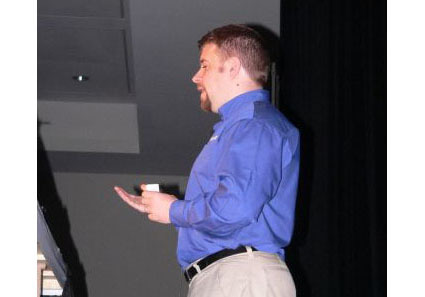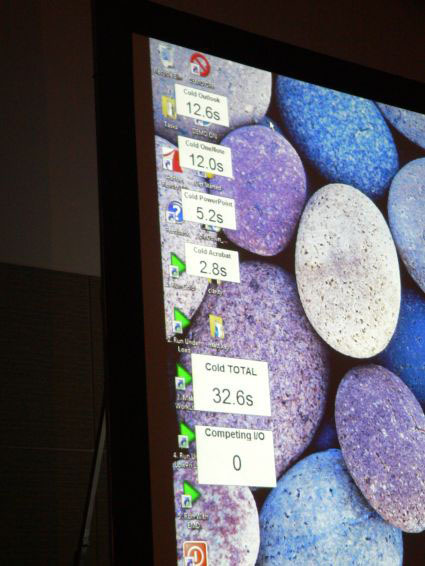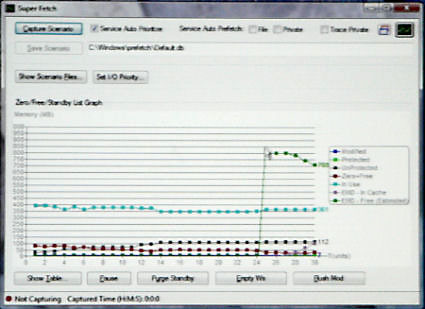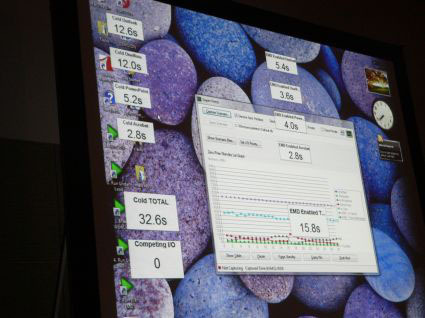Microsoft demonstrates SuperFetch technology
Microsoft Program Manager for Windows Client Performance Matt Ayers preparing to demonstrate SuperFetch, the company's new technology for requisitioning any Flash memory that's available, and putting it to work in speeding up the system.
Microsoft Program Manager for Windows Client Performance Matt Ayers preparing to demonstrate SuperFetch, the company’s new technology for requisitioning any Flash memory that’s available, and putting it to work in speeding up the system.
For the SuperFetch test, a script launches a battery of common Windows applications in sequence: Outlook, OneNote, PowerPoint, and Adobe Acrobat. Here, thus far, the test battery is in the middle of loading PowerPoint.
For the SuperFetch test, a script launches a battery of common Windows applications in sequence : Outlook, OneNote, PowerPoint, and Adobe Acrobat. Here, thus far, the test battery is in the middle of loading PowerPoint.
A process in the background keeps track of only the intervals of time between each application's call to launch and its signal of a ready state. For this ordinary HP 2 GHz notebook system with 512 MB of RAM, running the latest Vista beta, it takes over ha
A process in the background keeps track of only the intervals of time between each application’s call to launch and its signal of a ready state. For this ordinary HP 2 GHz notebook system with 512 MB of RAM, running the latest Vista beta, it takes over ha
The green line in this histogram represents the amount of Flash memory free for allocation by SuperFetch over time. Here, the system has just discovered it has an 800 MB USB key plugged in. This line will trend downward over the following minute, eventual
The green line in this histogram represents the amount of Flash memory free for allocation by SuperFetch over time. Here, the system has just discovered it has an 800 MB USB key plugged in. This line will trend downward over the following minute, eventual
When SuperFetch runs the first time, the system boot time speeds up by 15% - not particularly remarkable, but faster. What's important about this new memory manager is that it learns how to improve memory allocation over time. So the results you see here
When SuperFetch runs the first time, the system boot time speeds up by 15% - not particularly remarkable, but faster. What’s important about this new memory manager is that it learns how to improve memory allocation over time. So the results you see here
The setup for this particular ReadyDrive test is a bit tricky, so Matt Ayers captured it to video in advance, and brought the video with him. Here, Microsoft Word 2007 is running in Vista, while a bar graph scrolls along the bottom. The grey line represen
The setup for this particular ReadyDrive test is a bit tricky, so Matt Ayers captured it to video in advance, and brought the video with him. Here, Microsoft Word 2007 is running in Vista, while a bar graph scrolls along the bottom. The grey line represen
In this second, slightly revised test battery for SuperFetch, the first column represents standard application load times for the same four apps, after the system wakes up from suspension - slightly slower than normal. Next, the second column shows the lo
In this second, slightly revised test battery for SuperFetch, the first column represents standard application load times for the same four apps, after the system wakes up from suspension - slightly slower than normal. Next, the second column shows the lo
Get Tom's Hardware's best news and in-depth reviews, straight to your inbox.
The entire properties panel for setting the maximum amount of space from a ReadyBoost device, such as a USB key, to reserve as a read cache.
The entire properties panel for setting the maximum amount of space from a ReadyBoost device, such as a USB key, to reserve as a read cache.
Tom's Hardware is the leading destination for hardcore computer enthusiasts. We cover everything from processors to 3D printers, single-board computers, SSDs and high-end gaming rigs, empowering readers to make the most of the tech they love, keep up on the latest developments and buy the right gear. Our staff has more than 100 years of combined experience covering news, solving tech problems and reviewing components and systems.








